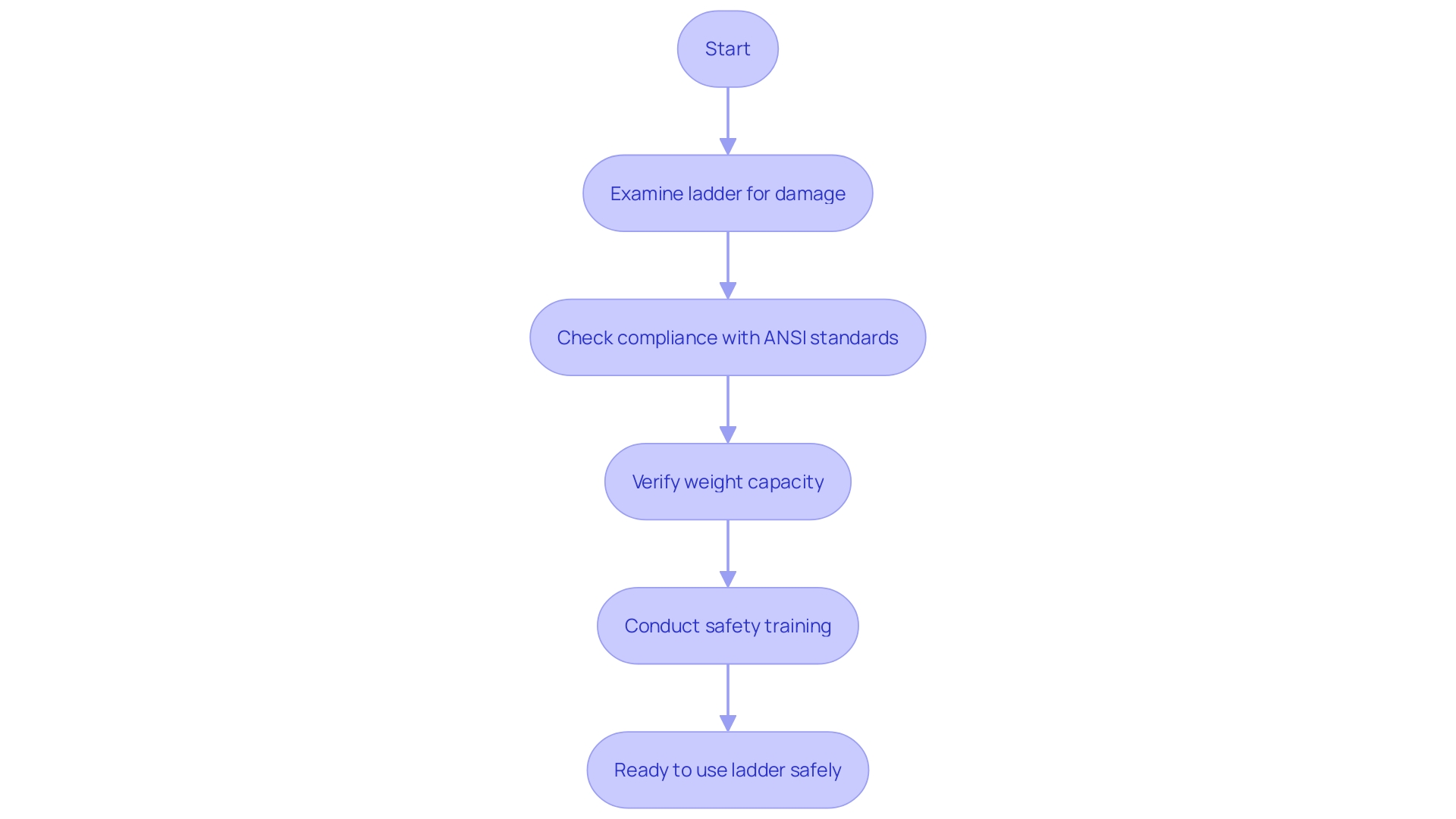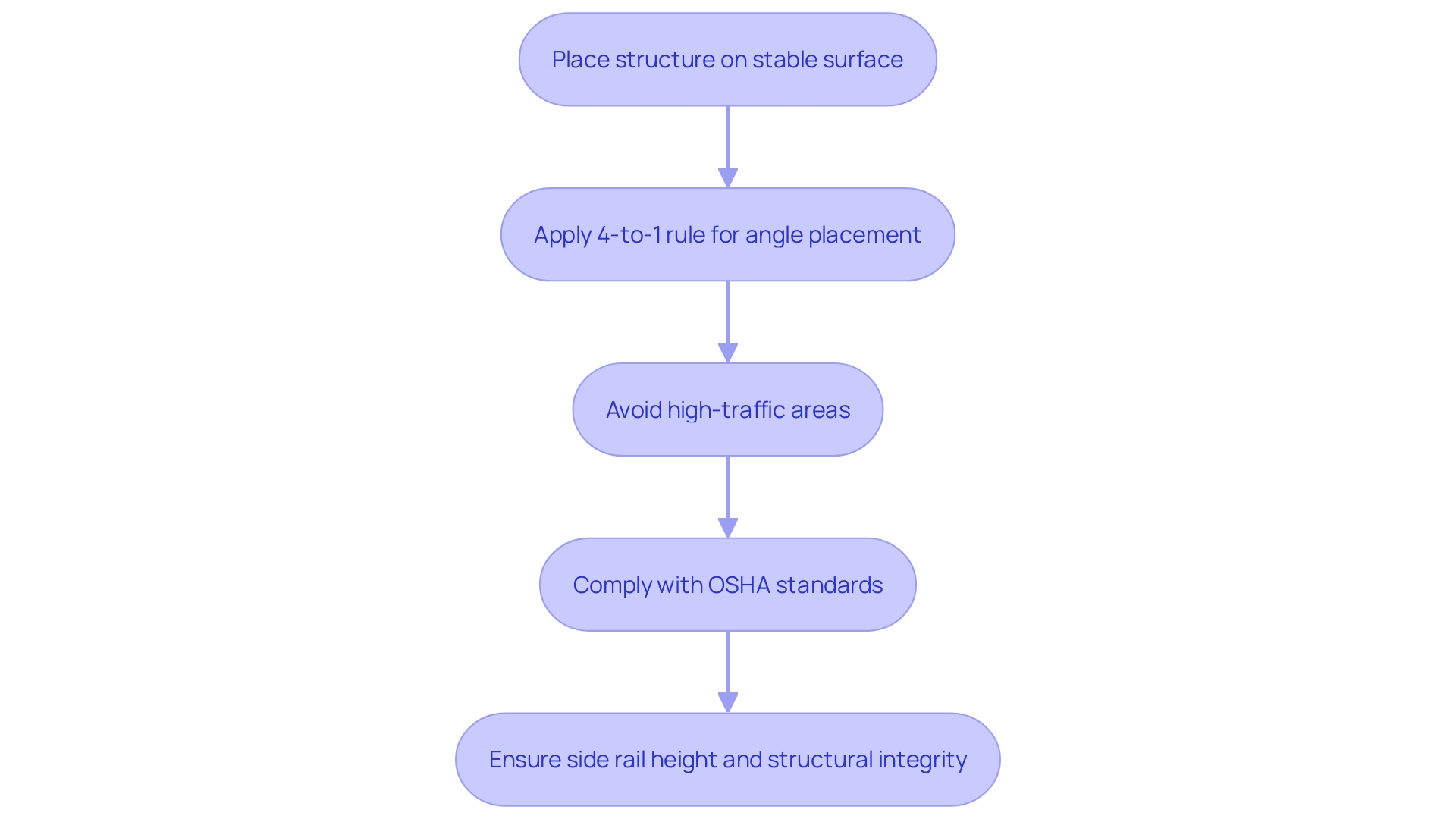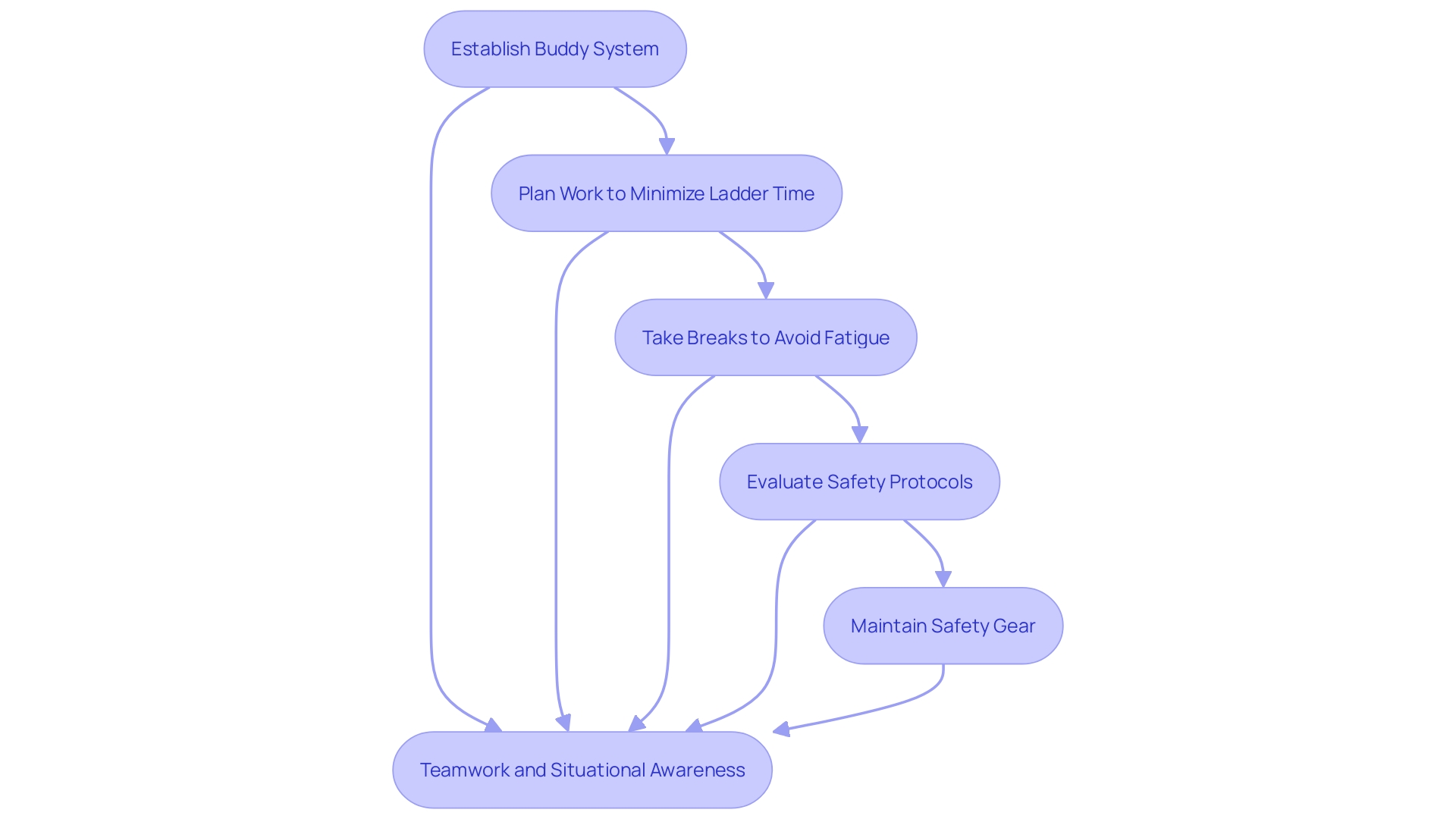Introduction
Using a 60-foot extension ladder comes with its unique set of challenges and risks, but with proper selection, inspection, and adherence to safety protocols, these risks can be effectively managed. This article delves into the critical aspects of ladder safety, starting with the importance of choosing the right ladder and conducting thorough inspections before use. It emphasizes the significance of proper ladder setup, positioning, and the adherence to OSHA regulations to ensure a secure working environment.
Furthermore, it covers essential climbing techniques and the necessity of maintaining three points of contact to prevent falls. Recognizing common hazards such as electrical lines and unstable ground, the article provides preventive measures to mitigate these risks. Training and compliance with OSHA regulations are highlighted as vital components in fostering a culture of safety.
Finally, best practices for safe ladder use, including the implementation of a buddy system and situational awareness, are discussed to enhance overall safety on the job site. By following these guidelines, workers can minimize accidents and ensure a safer working environment.
Ladder Selection and Inspection
Prior to using a 60-foot extension, it's vital to ensure it is suitable for the task at hand. Start with a comprehensive examination for any indications of harm, such as fractures, distortions, or rust, since these problems can jeopardize security. Pay special attention to the rungs, side rails, and feet to verify their stability. Only climbing devices that meet ANSI (American National Standards Institute) standards and are rated for the intended weight capacity, including the user and any tools, should be used. This guarantees compliance with protection regulations and reduces the risk of accidents. Consistent emergency exercises and employee education in appropriate equipment usage can further strengthen these precautions, promoting a culture of security at the work site.

Ladder Setup and Positioning
Ensuring proper setup is fundamental for safety when using a step structure. Start by placing the climbing structure on a stable, level surface, ensuring it is fully extended and secured in position. Adhere to the 4-to-1 rule for angle placement: for every four feet of height, the base should be one foot away from the wall or structure, minimizing the risk of tipping or sliding. Importantly, avoid positioning the climbing equipment in front of doorways or areas with high foot traffic to prevent accidents. According to OSHA standards, when these devices are used for access to an upper landing, the side rails must extend at least three feet above the landing surface, or the equipment should be securely fastened at the top to a rigid support. This guarantees extra stability and protection. Always ensure your climbing equipment is free of structural defects, such as broken rungs or split rails, and address any issues immediately to prevent accidents. Additionally, climbing devices should solely be utilized for their designed function to ensure security and effectiveness on the work site.

Climbing and Standing on Ladders
When utilizing a 60-foot extension device, ensuring safety is paramount. Always maintain three points of contact—either two hands and one foot or two feet and one hand. Positioning yourself towards the climbing equipment while ascending reduces the risk of falls, and it is essential to refrain from holding tools or materials in your hands. Utilize a tool belt or hoist them up once you’ve reached your working height.
Standing on the structure requires caution; never exceed the maximum standing level, typically the second to last rung, to maintain stability. This practice is essential to prevent mishaps such as the 2018 and 2022 occurrences in Florida and Kentucky, where individuals experienced serious injuries due to incorrect use of climbing equipment.
Contemporary extension devices are outfitted with characteristics such as non-slip bases and stabilizing rods, intended to improve stability and decrease the chances of mishaps. These advancements emphasize the significance of employing the right equipment and adhering to safety guidelines to prevent injuries.

Common Hazards and Preventive Measures
When employing a high scaffold, it's essential to identify and address possible dangers to avoid mishaps. Electrical lines, unstable ground, and adverse weather conditions are significant risks. Ensure you maintain a safe distance from power lines, as contact can be fatal. Ground stability is essential; always check that the ground is firm and free from slipperiness to avoid falls. Secure the framework with suitable tools or have a companion keep it stable whenever feasible. Strong winds and storms pose a significant risk when employing step tools; it’s advisable to refrain from their use during these circumstances. The tragic incident at Northridge Construction Corporation, where an employee fell from an improperly secured roof, emphasizes the importance of following security guidelines. OSHA's regulations, such as ensuring stability of climbing equipment and implementing fall protection systems, are in place to prevent such tragedies. Implementing these protective measures can reduce the risk of accidents and guarantee a more secure working environment.

Training and Compliance with OSHA Regulations
Making sure that all staff using a 60-foot ladder are adequately trained in ladder procedures is essential for upholding a secure work atmosphere. OSHA regulations require thorough training sessions, including regular updates, to keep everyone informed on the latest standards for protection. As per OSHA's guidelines, employers are accountable for ensuring secure work environments, which involves properly training staff to reduce risks and adhere to health regulations. Recent updates to OSHA's regulations emphasize the importance of ongoing education and compliance to prevent workplace incidents and injuries.
Training programs should be tailored to address specific hazards associated with different types of equipment and job roles. Engaging and accessible training material is vital to guarantee that all employees, regardless of their location or role, can effectively learn and apply protective procedures. 'Compliance training not only meets legal obligations but also boosts employee confidence, decreases workplace mistakes, and shows the employer's dedication to their team's well-being and development.'.
A case in point is the recent corporate-wide settlement between OSHA and Dollar General, which underscores the significance of systematic risk management improvements. Dollar General agreed to implement significant changes, including hiring additional managers for security and establishing a robust health management system. This initiative aims to prioritize worker protection and ensure employees can perform their duties without risking their well-being.
Regularly reviewing and updating protection policies in line with the latest OSHA regulations is vital. Employers should actively seek employee feedback to create a safer work environment and foster a culture of communication and commitment to health and well-being. By diligently adhering to these practices, companies can enhance the effectiveness of their protection policies and ensure a secure workplace for all workers.
Best Practices for Safe Ladder Use
Improving protection during the use of a 60-foot climbing tool is essential to avoid severe mishaps. Establish a buddy system to guarantee an extra set of eyes can recognize potential dangers, significantly improving standards of protection. This approach mirrors the advice of experts who emphasize the importance of situational awareness and working together to reduce risks. Plan your work to minimize the time spent on the ladder and take breaks as needed to avoid fatigue, which can lead to mistakes and accidents.
Consistently evaluating protocols for well-being and promoting a culture of protection among team members is crucial. Encourage everyone to be vigilant about their surroundings, such as power lines or unstable ground, and to communicate any concerns immediately. By promoting a proactive approach to well-being, you can create a more secure working environment and enhance accountability among workers. Remember, maintaining safety gear and following proper maintenance procedures are non-negotiable aspects of ensuring overall safety while using such tall equipment.

Conclusion
Ensuring safety when using a 60-foot extension ladder involves a comprehensive approach that encompasses ladder selection, setup, climbing techniques, and adherence to safety regulations. Selecting the right ladder, conducting thorough inspections, and ensuring compliance with ANSI standards are foundational steps that significantly reduce risks. Regular training and drills further reinforce these safety measures, creating a culture of awareness and responsibility on job sites.
Proper ladder setup and positioning are critical to preventing accidents. Adhering to the 4-to-1 rule, ensuring the ladder is on stable ground, and avoiding high-traffic areas can mitigate the risks associated with falls and tipping. Additionally, understanding and recognizing common hazards, such as electrical lines and adverse weather conditions, allows workers to take proactive measures to ensure their safety.
Training and compliance with OSHA regulations remain essential components of ladder safety. Regular training sessions equip workers with the knowledge needed to navigate the challenges associated with ladder use. Implementing a buddy system and promoting situational awareness further enhances safety by fostering teamwork and communication among workers.
By prioritizing these best practices, organizations can create a safer working environment, significantly reducing the likelihood of accidents and injuries associated with ladder use.




